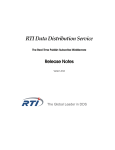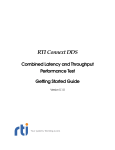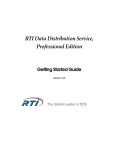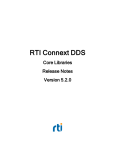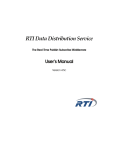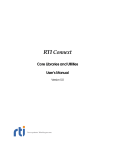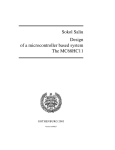Download What`s New - Community RTI Connext Users
Transcript
RTI Connext Core Libraries and Utilities What’s New in Version 4.5f © 2012 Real-Time Innovations, Inc. All rights reserved. Printed in U.S.A. First printing. March 2012. Trademarks Real-Time Innovations, RTI, DataBus, and Connext are trademarks or registered trademarks of Real-Time Innovations, Inc. All other trademarks used in this document are the property of their respective owners. Copy and Use Restrictions No part of this publication may be reproduced, stored in a retrieval system, or transmitted in any form (including electronic, mechanical, photocopy, and facsimile) without the prior written permission of Real-Time Innovations, Inc. The software described in this document is furnished under and subject to the RTI software license agreement. The software may be used or copied only under the terms of the license agreement. Technical Support Real-Time Innovations, Inc. 232 E. Java Drive Sunnyvale, CA 94089 Phone: (408) 990-7444 Email: [email protected] Website: https://support.rti.com/ Contents 1 Introducing RTI Connext ..................................................................................................................... 1 2 New Architectures ................................................................................................................................ 2 3 Experimental Features ......................................................................................................................... 2 4 Experimental Feature: XML-Based Application Creation .............................................................. 3 5 Change to Default Value for UDPv4 Transport Property reuse_multicast_receive_resource ... 3 6 New UDPv4 Transport Property to Set Protocol Overhead ........................................................... 3 7 More Flexibility in Allow/Deny Interface Specification for UDPv6 transport ........................... 4 8 Ability to Configure EntityFactoryQosPolicy in DomainParticipantFactory using XML ......... 4 9 C++ Code Generation Enables Easier C++ Template Programming ............................................ 5 10 Interoperability Between 64-bit and 32-bit Connext Applications using Shared Memory........ 6 11 Support for Circular Dependencies on Included Files in XML Type Declarations..................... 6 iii iv What’s New This document highlights new or changed features in RTI® Connext™ (formerly RTI Data Distribution Service) 4.5f. (For details on fixed bugs, please see the Release Notes.) For more information, visit the RTI Knowledge Base, accessible from https://suppor.rti.com/, to see sample code, general information on Connext, performance information, troubleshooting tips, and technical details. By its very nature, the knowledge base is continuously evolving and improving. We hope that you will find it helpful. If there are questions that you would like to see addressed or comments you would like to share, please send e-mail to [email protected]. We can only guarantee a response to customers with a current maintenance contract or subscription. You can purchase a maintenance contract or subscription by contacting your local RTI representative (see http:// www.rti.com/company/contact.html), sending an e-mail request to [email protected], or calling +1 (408) 990-7400. 1 Introducing RTI Connext RTI's family of products is now called RTI Connext™. RTI Connext is the first edge-toenterprise real-time SOA platform. The products provide seamless, enterprise-wide integration to improve efficiency, responsiveness and integration with real-time business intelligence (BI). With this release the RTI Connext family of products includes: ❏ RTI Connext DDS is the leading implementation of the Object Management Group (OMG) Data Distribution Service (DDS) specification. The proven technology is the foundation of the RTI Connext product family. ❏ RTI Connext Messaging provides a universal messaging infrastructure for ultra high-performance and real-time systems, including machine-to-machine (M2M) 1-1 and human-machine interface (HMI) applications. It includes APIs for JMS and DDS, Persistence Service for late joiners, Recording Service for logging data for deep analysis and archiving, Federation Service for securely bridging applications and systems across both local and wide area networks, and tools for monitoring, analyzing and debugging your complete system. ❏ RTI Connext Integrator delivers rapid integration of operational systems with enterprise-wide IT without requiring modification to those systems. Connext Integrator is a service bus, similar to an enterprise service bus (ESB), but designed for the demanding real-time environment. It provides the backbone of a realtime Service Oriented Architecture (SOA). 2 New Architectures Connext 4.5f adds support for the following new architectures: SUSE Linux Enterprise 11 AMD64 Server Service Pack 1 (2.6 kernel) RedHawk Linux 6.01 64-bit PPC 604 LynxOS 4.0 gcc 4.3.4 x64Linux2.6gcc4.3.4 Sun Java Platform Standard Edition JDK x64Linux2.6gcc4.3.4jdk 1.6 gcc 4.4.5 x64Linux2.6gcc4.4.5 gcc 3.2.2 ppc750Lynx4.0.0gcc3.2.2 Sun Java Platform PPC 7XX Standard Edition JDK (such as 750) 1.4 ppc750Lynx4.0.0gcc3.2.2jdk 1. This platform is only available as a Custom Target Library (CTL). Contact [email protected] for details. It uses the same target libraries as Red Hat Enterprise Linux 6.1. 3 Experimental Features This release introduces the concept of experimental features, which are used to evaluate potential new features and obtain customer feedback. They are not guaranteed to be consistent or supported and they should not be used in production. Experimental features are clearly documented as such in the Core Libraries and Utilities What’s New document or the Release Notes document of the component in which they are included, as well as in the component’s User’s Manual. 1-2 Experimental Feature: XML-Based Application Creation For more information on the concept of experimental features, see the RTI Core Libraries and Utilities Release Notes. 4 Experimental Feature: XML-Based Application Creation In this release, you can evaluate an experimental feature (see Section 3) known as XMLBased Application Creation. This feature simplifies the development and programming of RTI Connext applications by allowing you to define your entire system using XML. With previous releases, you could define data types and Quality of Service settings in XML. With this feature, you can also use XML to define your system’s Topics, DomainParticipants, and all the Entities they contain (Publishers, Subscribers, DataWriters and DataReaders). For details on using this feature, see the XML-Based Application Creation Getting Started Guide (RTI_Connext_XML_AppCreation_GettingStarted.pdf). Note: Experimental features cannot be used in a production system. See the Release Notes for more information. 5 Change to Default Value for UDPv4 Transport Property reuse_multicast_receive_resource The default value for the UDPv4 transport property, reuse_multicast_receive_resource, has been changed from disabled to enabled. This change prevents Linux applications running with the Linux firewall enabled from hanging during DomainParticipant shutdown. [RTI Bug # 14221] 6 New UDPv4 Transport Property to Set Protocol Overhead In the UDPv4 transport, the existing property message_size_max does not account for UDPv4 and IP headers. As a result, sizing message_size_max too close to the UDPv4 datagram size limit of 65535 bytes will result in messages too large for the DataWriter to send. A new UDPv4 transport property, protocol_overhead_max, accounts for the pro- 1-3 tocol overhead, as well as any other protocol-related overhead; it is set by default to account for UDPv4 and IPv4 headers. Furthermore, the middleware will automatically limit the effective message_size_max to be no larger than the UDPv4 limit (65535) minus this overhead. 7 More Flexibility in Allow/Deny Interface Specification for UDPv6 transport This release provides more flexibility in terms of filter specification for allowing or denying interfaces for the UDPv6 transport. The new method is case-insensitive and accepts addresses and patterns in IPv6 notation. It also supports the wildcard character, *, which can expand up to 4 digits in a block. The wildcard must be either leading or trailing. Multiple wildcards can be specified in a single filter, but only one wildcard can be specified per block (between colons). Examples of valid filters: Filter Same as *:*:*:*:*:*:*:* Matches Any IPv6 interface fe80::*:* FE80::*:* Fe80:0:0::*:* FE80:0000:0000:0000:0000:0000:xxxx:xxxx Fe80:0:0:0:0:0:*:* FE80:aBC::202:2*:*:*2 FE80:0ABC:0000:0000:0202:2xxx:xxxx:xxx2 eth* eth0, eth1, etc. [RTI Bug # 14075] 8 Ability to Configure EntityFactoryQosPolicy in DomainParticipantFactory using XML This release adds the ability to configure the EntityFactoryQosPolicy in the DomainParticipantFactory using XML. This is done using a new XML tag called <entity_factory> under <participant_factory_qos>. For example: <participant_factory_qos> <entity_factory> 1-4 C++ Code Generation Enables Easier C++ Template Programming <autoenable_created_entities>false</autoenable_created_entities> </entity_factory> </participant_factory_qos> 9 C++ Code Generation Enables Easier C++ Template Programming The C++ type definition for structs, valuetypes, and unions has been enhanced with traits and definitions for DataWriter, DataReader, TypeSupport, and Sequence in order to make template programming easier. For example, the Foo IDL type below generates the following C++ type definition: IDL: struct Foo { short myShort; }; C++: typedef struct Foo { #ifdef __cplusplus typedef struct FooSeq Seq; #ifndef NDDS_STANDALONE_TYPE typedef FooTypeSupport TypeSupport; typedef FooDataWriter DataWriter; typedef FooDataReader DataReader; #endif #endif DDS_Short myShort; } Foo; The above type definition will make it easier for you to create class templates using Foo as the type parameter. For example (note: error checking omitted for the sake of brevity): template <typename T> void take_and_print(typename T::DataReader* reader) { DDS_SampleInfo info; T * sample = T::TypeSupport::create_data(); DDS_ReturnCode_t result = reader->take_next_sample(*sample, info); 1-5 if (result == DDS_RETCODE_OK && info.valid_data) { T::TypeSupport::print_data(sample); } T::TypeSupport::delete_data(sample); } void main(int argc, char ** argv) { // ... FooDataReader foo_dr = ...; BarDataReader bar_dr = ...; // ... take_and_print<Foo>(foo_dr); take_and_print<Bar>(bar_dr); } 10 Interoperability Between 64-bit and 32-bit Connext Applications using Shared Memory Previous releases already supported interoperability with the release core libraries. However, applications using the debug libraries failed with the following error message: REDAConcurrentQueue_attach:!precondition: !((((RTI_UINT64)(memAddress)) % (sizeof(struct REDAConcurrentQueueStructToDetermineAlignment))) == 0) NDDS_Transport_Shmem_attach_writer:failed to initialize unable to attach This release adds interoperability over shared memory using the debug core libraries. 11 Support for Circular Dependencies on Included Files in XML Type Declarations In previous releases, the following XML type declarations were not allowed since there were circular dependencies between the included files in types1.xml and types2.xml: 1-6 Support for Circular Dependencies on Included Files in XML Type Declarations types1.xml <types> <include file="types2.xml"/> <struct name="MyPrimitiveStruct" topLevel="true"> <member name="m1" type="boolean"/> <member name="m2" type="octet"/> <member name="m3" type="char"/> <member name="m4" type="nonBasic" nonBasicTypeName="MyPrimitiveStruct2"/> </struct> </types> types2.xml <types> <include file="types1.xml"/> <!-- This was not allowed --> <struct name="MyPrimitiveStruct2" topLevel="true"> <member name="m1" type="boolean"/> <member name="m2" type="octet"/> <member name="m3" type="char"/> </struct> </types> This problem has been fixed in this release and circular dependencies on included files are allowed. Notice that circular dependencies on included files are not the same as circular dependencies on types. For example, the following XML is still not allowed: types1.xml <types> <include file="types2.xml"/> <struct name="MyPrimitiveStruct" topLevel="true"> <member name="m1" type="boolean"/> <member name="m2" type="octet"/> <member name="m3" type="char"/> <member name="m4" type="nonBasic" nonBasicTypeName="MyPrimitiveStruct2"/> </struct> </types> 1-7 types2.xml <types> <include file="types1.xml"/> <!-- This is allowed --> <struct name="MyPrimitiveStruct2" topLevel="true"> <member name="m1" type="boolean"/> <member name="m2" type="octet"/> <member name="m3" type="char"/> <member name="m4" type="nonBasic" nonBasicTypeName="MyPrimitiveStruct"/> <!-- Not allowed --> </struct> </types> 1-8













